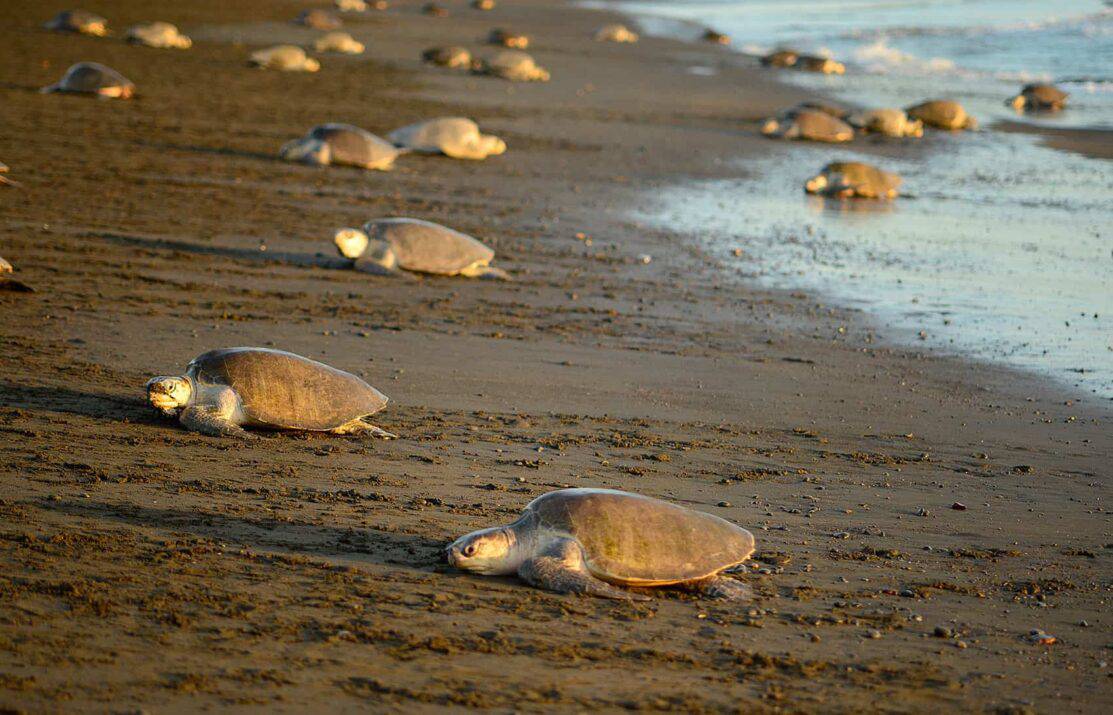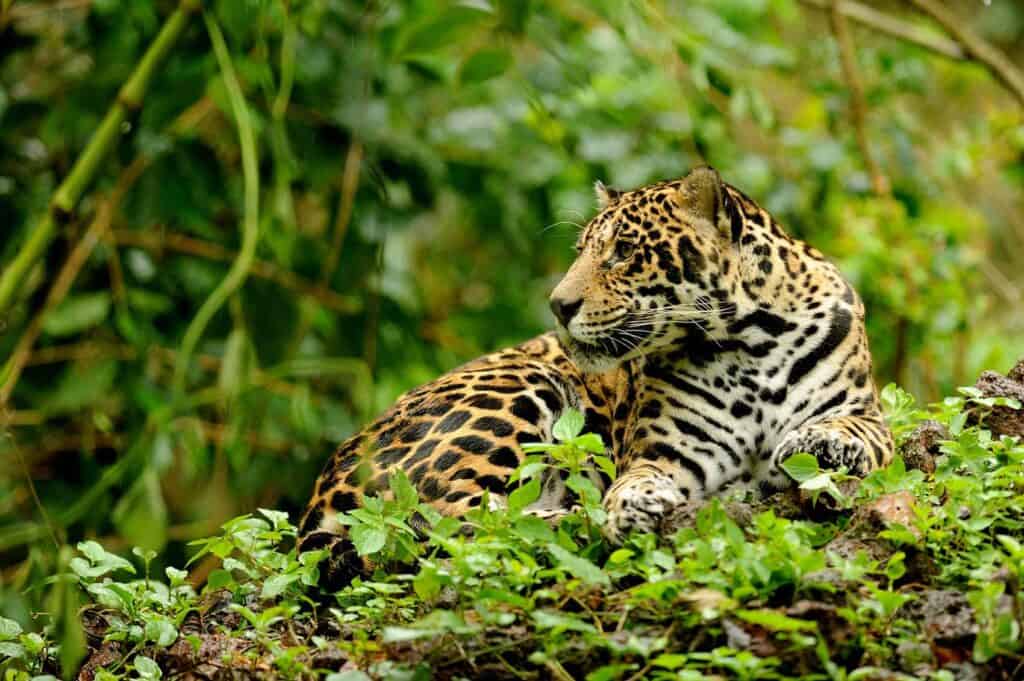
Costa Rica, a small country teeming with biodiversity, is home to over 5% of the world’s species. This tropical haven offers wildlife enthusiasts unparalleled opportunities to observe iconic animals in their natural habitats.
From the elusive jaguar to the vibrant strawberry poison dart frog, Costa Rica’s diverse ecosystems support an incredible array of wildlife.
In this article, we’ll explore 10 iconic animals you can see in Costa Rica, showcasing the country’s rich biodiversity and highlighting its importance in global conservation efforts.
Introduction to Costa Rica’s Biodiversity
Costa Rica is a key spot for biodiversity, with over 5% of the world’s species in a small area. It’s full of life, from howler monkeys to jaguars and toucans. The mix of tropical climate and varied land creates many microclimates, supporting this rich diversity.
The Monteverde Cloud Forest Reserve is a top spot for nature fans. It’s famous for the resplendent quetzal, a beautiful bird of the cloud forests. Visitors to places like Manuel Antonio National Park and Tortuguero National Park can see three-toed sloths up close, adding to their eco-tourism adventures.
Costa Rica protects over a quarter of its land, showing its commitment to the environment. This highlights the value of protecting wildlife and supports eco-tourism. The forests here store about 200 million metric tons of carbon, helping fight climate change.
Costa Rica is one of the most biodiverse places on Earth, home to 500,000 species. Eco-tourists can see many animals, like six types of toucans and four monkey species. Its rich wildlife and conservation efforts make Costa Rica a leader in eco-tourism.
The Significance of Wildlife Conservation in Costa Rica
Costa Rica is a key player in wildlife conservation, thanks to its incredible biodiversity. It’s home to over 500,000 species, making it one of the most diverse places on Earth. The country has set aside more than 25% of its land for national parks and protected areas. These places are safe havens for many species, helping them to survive.
Groups like GVI are leading the fight against conservation challenges. They have programs like the Jaguar Conservation Program and the Sea Turtle Conservation Program. These programs protect endangered species and monitor their populations. For example, thousands of sea turtles come to Costa Rica’s beaches every year to lay eggs. Conservation efforts, like patrolling and educating the community, help protect these delicate events.
National parks like Tortuguero and Corcovado let visitors see Costa Rica’s wildlife up close while keeping the environment balanced. These parks are safe havens for animals and attract tourists who want to see them in their natural setting. Visitors are taught to keep a safe distance from the animals and support tours that treat wildlife with respect.
| National Park | Key Species | Best Visiting Time |
|---|---|---|
| Tortuguero | Sea turtles, howler monkeys, diverse bird species | July to October (nesting season) |
| Monteverde Cloud Forest Reserve | Resplendent quetzal, various bird species | December to April (dry season) |
| Corcovado | Jaguar, scarlet macaws, monkeys | Year-round, with peak wildlife visibility |
| Caño Negro Wildlife Refuge | Herons, egrets, tapirs | Year-round, best during wet season for bird watching |
Costa Rica’s efforts in wildlife conservation protect its unique biodiversity and support eco-tourism. This creates a balance between nature and local communities.
Coatis: Costa Rica’s Curious Creatures
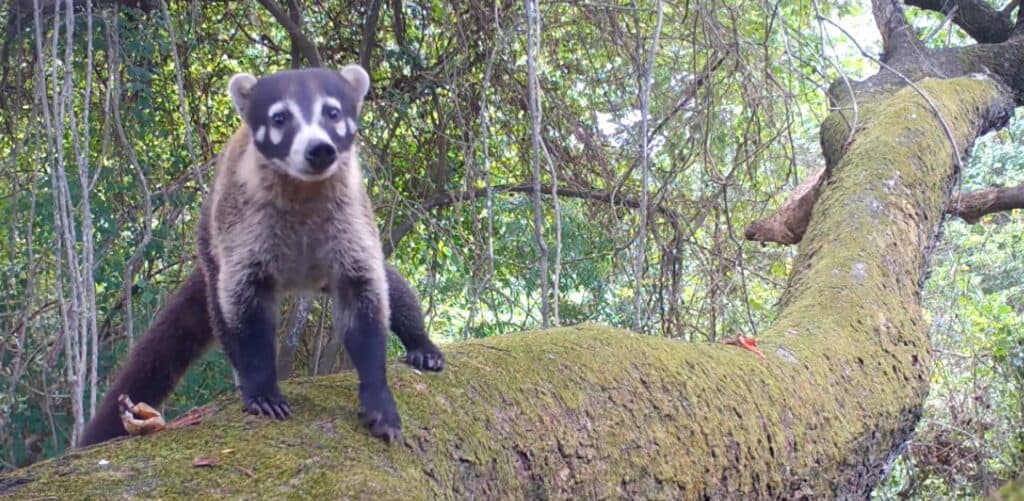
Coatis look like furry cousins of raccoons and live in many national parks in Costa Rica. Places like Manuel Antonio and Cahuita are home to these animals. They live in groups of 10 to 30, with more females and their kids than males.
Coatis love different kinds of places, from rainforests to wetlands by the coast. They are good at living in various environments. This helps them play a big part in the local wildlife and conservation efforts.
Coatis are often seen looking for food, using their strong smell and long snouts. They eat insects, fruits, small mammals, and even birds.
- A baby coati, known as a kit, typically weighs around 3 ounces at birth.
- Litters usually consist of 3 to 6 young, following a gestation period of 75 days.
- Coatis reach sexual maturity at two years, with a wild lifespan of 7 to 12 years.
When visiting places where coatis live, be careful not to feed them. Keep your snacks away to keep a safe distance. Seeing coatis in the wild is a special experience in Costa Rica.
| Coati Facts | Details |
|---|---|
| Weight | 4 to 6 kg (up to 9 pounds) |
| Group Size | 10 to 30 individuals |
| Breeding Season | During rainy season, linked to food availability |
| Lifespan | Wild: 7 to 12 years; Domesticated: up to 16 years |
| Natural Predators | Ocelots, hawks, jaguars, and boa constrictors |
| Species Status | Not considered threatened |
Domesticating coatis can lead to aggressive behavior as they get older. Costa Rica is working hard to protect these animals and the many species living in its national parks.
Crocodiles: Giants of the Rivers
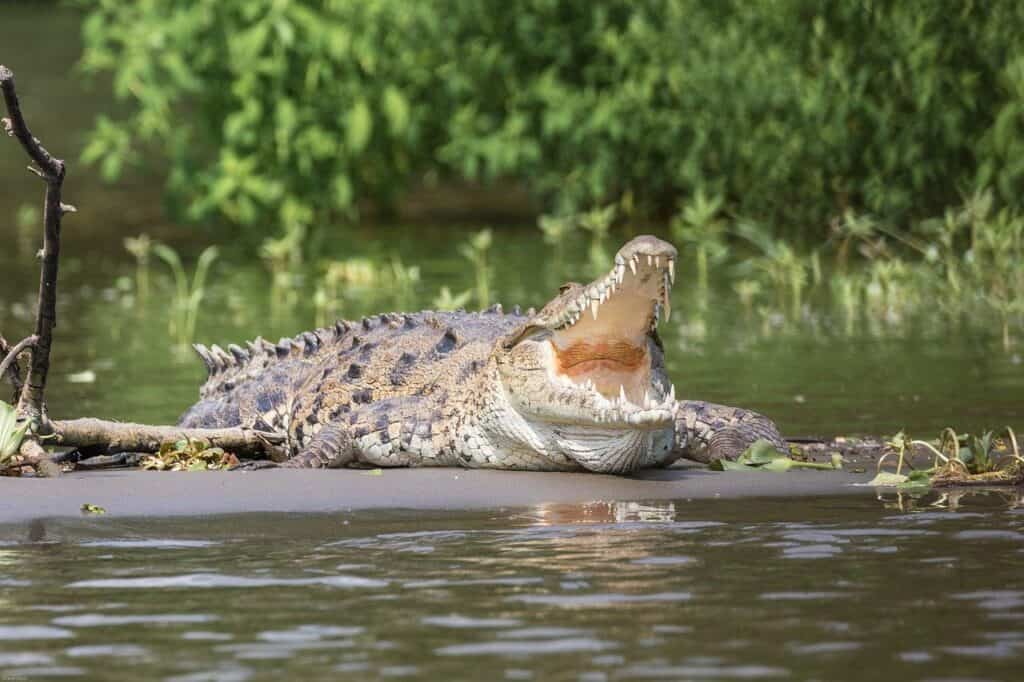
Costa Rica is home to the amazing American crocodile. These creatures are up to 20 feet long and live in wetlands and rivers. Tourists flock to places like the Rio Tarcoles to see them, especially near the famous Crocodile Bridge.
The American crocodile is key to the health of rivers. They keep the ecosystem balanced by controlling other species. This helps many other animals live in Costa Rica. Seeing these reptiles in the wild is a big draw for eco-tourists.
- American crocodiles can weigh between 800 to 1200 pounds.
- They are classified as “Vulnerable” due to habitat loss and other threats.
- Tool-assisted tours exist for observing crocodiles, though direct interaction is discouraged.
- Crocodile populations are particularly visible at the Rio Tarcoles, a hotspot for eco-tourism.
- Over a quarter of Costa Rica is designated as a national park or protected area, providing safe habitats for wildlife.
These reptiles are huge and deserve our respect. It’s important to stay away from them. Getting too close can be dangerous, and there are yearly reports of humans getting hurt in Costa Rica. Let’s enjoy watching crocodiles from afar, keeping everyone safe.
| Species | Average Size | Average Weight | Conservation Status |
|---|---|---|---|
| American Crocodile | 4 meters (13 feet) | 800 – 1200 lbs | Vulnerable |
| Spectacled Caiman | 1 to 2.5 meters (3 to 8 feet) | 100 – 300 lbs | Least Concern |
10 Iconic Animals You Can See in Costa Rica
Costa Rica is a haven for wildlife, despite being just a tiny part of the Earth. It’s home to over 5% of the world’s species, thanks to its diverse geography and climate. You can spot jaguars, sloths, and toucans, among others, adding to the country’s rich ecosystem.
- Jaguars: These big cats are key to keeping their ecosystems balanced. Costa Rica is home to six wild cat species, including jaguars.
- Sloths: With their slow pace, sloths are fascinating creatures. They have the lowest metabolism of any animal, living in Costa Rica.
- Toucans: These colorful birds are known for their large, bright beaks. There are six types of toucans, a delight for bird lovers.
- Baird’s Tapir: As the biggest land mammal in Central America, the Baird’s Tapir helps spread seeds through its habitat.
- Howler Monkeys: These monkeys are the loudest on land in the Western Hemisphere. They add a lively touch to Costa Rica’s forests.
- Kinkajous: These mammals love fruits and are known for their honey raids at night.
- Spider Monkeys: These endangered primates show why conservation is crucial in Costa Rica’s diverse lands.
- Northern Tamandua: This anteater eats only ants and termites, playing a vital role in the ecosystem.
- Silky Anteater: This tiny, nocturnal animal is essential to the region’s biodiversity.
- Bats: Costa Rica has more bat species than rodents, adding to its rich ecosystem.
When visiting Costa Rica, it’s important to watch wildlife responsibly. This way, these iconic animals can continue to thrive for future generations.
Jaguars: The Elusive Top Predator

In Central America, jaguars are the biggest cats, known for their beautiful coat. They are more than just beautiful; they keep the ecosystem balanced. They weigh 100 to 250 pounds and can be up to 7.8 feet long, making them the third-largest feline after the tiger and lion.
Despite their size, jaguars are in danger, with only about 15,000 left in the wild. Habitat loss, poaching, and conflicts with humans put them at risk. Costa Rica protects over a quarter of its land for these animals. Places like Tortuguero and Corcovado are key for their survival.
Jaguars are hard to see, making spotting them exciting but rare. People go to Costa Rica’s parks to try and see them. Their ability to hide makes them even harder to find, even for experts.
Protecting jaguars and their homes is crucial. Costa Rica works on connecting habitats and teaching sustainable living. It also involves local communities in protecting wildlife. These efforts help keep jaguars and other animals safe.
| Statistic | Details |
|---|---|
| Population | Approximately 15,000 jaguars left in the wild |
| Weight | 100 to 250 pounds on average |
| Length | Up to 7.8 feet |
| Protection | Over 25% of Costa Rica is designated as protected reserves |
| Key Locations for Sightings | Tortuguero National Park, Corcovado National Park, Osa Peninsula |
| Conservation Status | Near-threatened species |
Jaguars are vital for their ecosystems. They keep other animals’ populations in check. Learning about jaguars helps us appreciate and protect these amazing animals.
Monkeys: The Playful Primates of Costa Rica
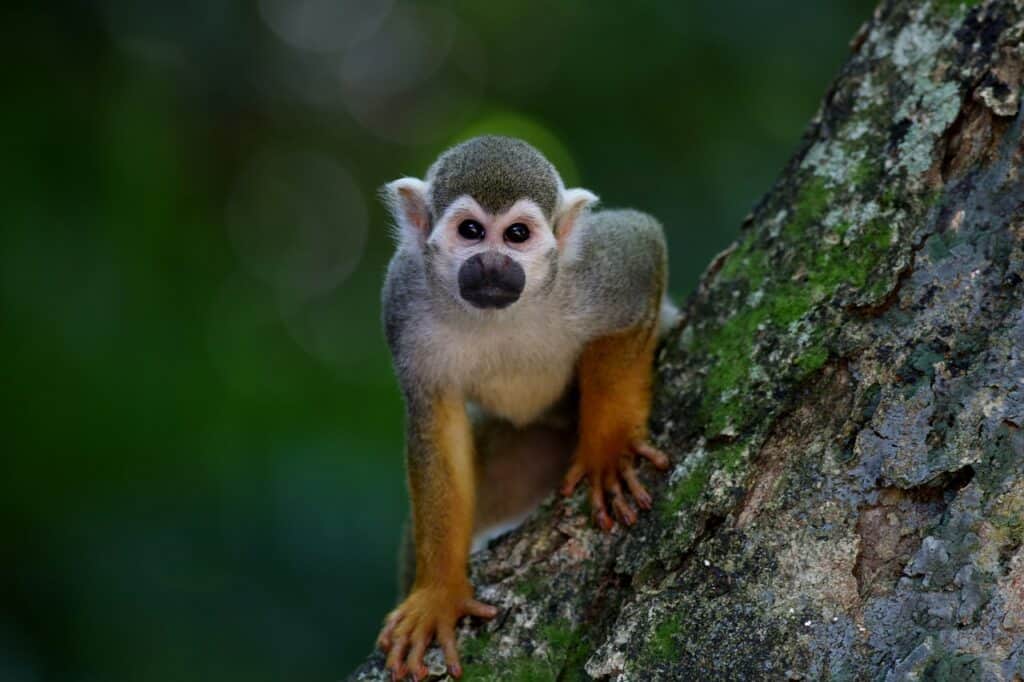
Costa Rica is home to more monkeys than people, thanks to its rich biodiversity. You can find four main types: Central American squirrel monkeys, howler monkeys, capuchin monkeys, and spider monkeys. Each species has its own unique traits and social behaviors that draw in visitors.
Squirrel monkeys live in groups of about 30, showing off their playful nature. These small, endangered primates weigh just 1-2 pounds. Seeing them is a rare delight, best during the dry season from December to April.
Howler monkeys are famous for their loud calls, heard up to three miles away. They live in groups of 10 to 20, showing off their social life. Their calls can hit up to 140 decibels, making the forest come alive.
Geoffroy’s spider monkeys have a special tail that acts as an extra limb. They are big, over 13 pounds, and can stretch up to five feet long. Their social life is all about bonding and communicating to survive.
Capuchin monkeys are smart and live in groups of 10 to 30. They can weigh up to 9 pounds and have a long, prehensile tail. Their clever actions often amaze visitors.
Costa Rica works hard to protect these playful primates. Groups like Kids Saving the Rainforest offer tours and volunteer chances to help with habitat issues. National parks like Rincón de la Vieja are safe havens for monkeys, helping the environment.
Strawberry Poison Dart Frogs: Colorful but Cautionary
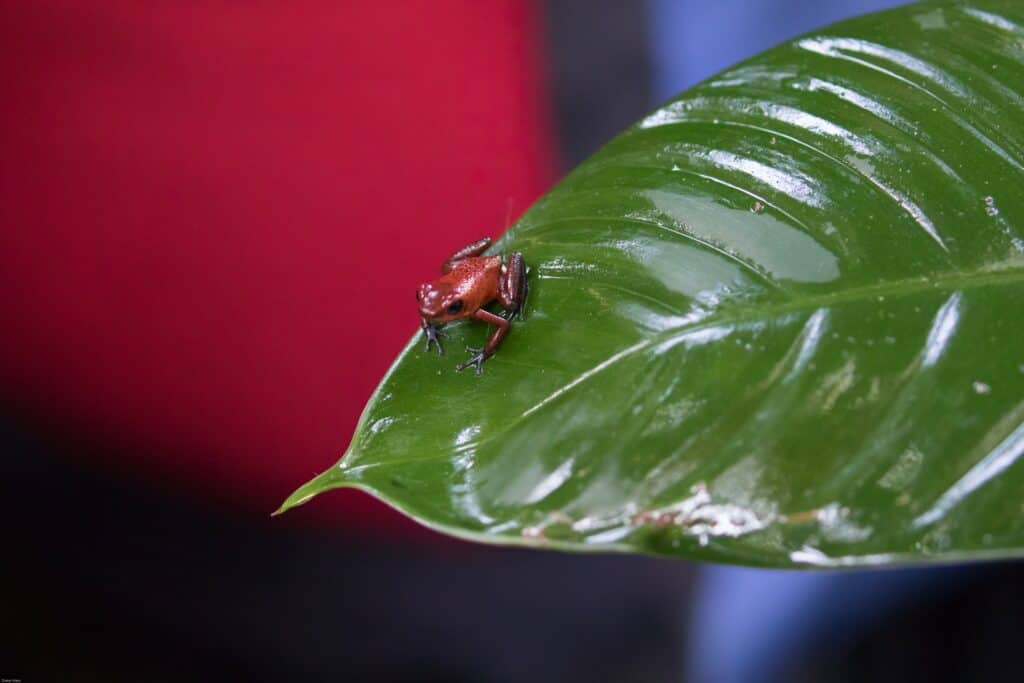
The strawberry poison dart frog is a bright sight in Costa Rica’s wildlife. They are known for their bright colors and are toxic. This warns predators to stay away. These frogs live in the humid rainforests of the Caribbean side and are key to their ecosystem’s health.
It’s vital to protect these frogs. Even though they are not considered endangered, they face threats from losing their homes and climate change. There are about 15 to 30 different types of these frogs, each one unique. This shows how important it is to save their homes to keep the ecosystem diverse.
- Size: Adult frogs measure between 0.7-1 inch (1.7-2.5 cm).
- Lifespan: They can live for 10 to 17 years.
- Temperature Range: Preferable conditions range from 75-82°F (24-28°C).
- Geographical Distribution: Endemic to Nicaragua, Costa Rica, and Panama.
- Diet: Primarily feed on ants.
- Breeding Behavior: Females choose males based on their looks and calls.
- Parental Care: Both parents take care of the tadpoles, feeding them with unfertilized eggs.
It’s best to watch these frogs from afar because they are toxic. Their bright colors are amazing but also remind us of the importance of protecting wildlife. We must keep these frogs and their homes safe to maintain the area’s biodiversity.
Sloths: The Slow-Moving Icons of the Jungle
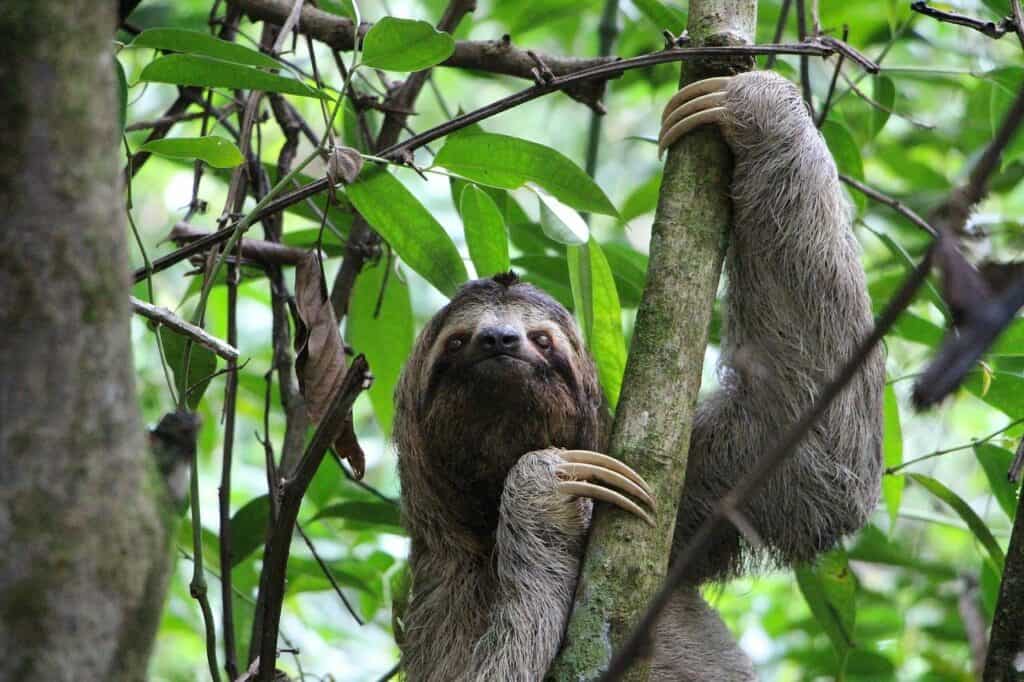
Costa Rica is famous for its unique wildlife, especially its sloths. It’s home to the Hoffmann’s two-toed and brown-throated sloths. These slow-moving creatures live in the tree canopies, blending in perfectly with their surroundings.
Finding sloths can be tough because they hide among the leaves. Their numbers are dropping due to deforestation. They have babies only once every three years, making their population grow slowly.
Many national parks in Costa Rica are great for seeing these gentle animals. Some top places include:
- Manuel Antonio National Park, a top spot for wildlife and sloth sightings.
- Tortuguero National Park, on the Caribbean coast, is perfect for seeing two-toed and three-toed sloths.
- Corcovado National Park, a hotspot for biodiversity, lets you see sloths in a diverse ecosystem.
- Arenal Volcano National Park, rich in wildlife, is great for observing sloths in nature.
- Cahuita National Park, known for its rainforest, is full of sloths and coastal beauty.
Eco-tourism in these parks helps protect wildlife and their homes. Seeing sloths in their natural setting connects us to nature. It makes us appreciate Costa Rica’s national parks and their biodiversity.
Toucans: The Colorful Birds of Costa Rica
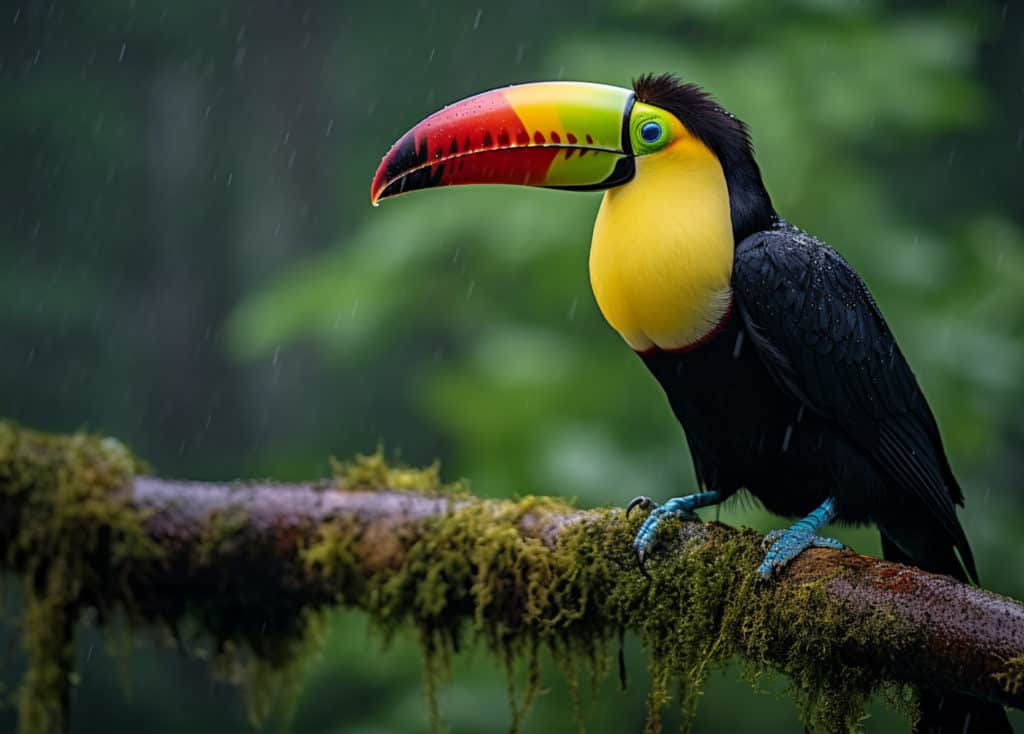
Toucans are iconic birds in Costa Rica, known for their bright bills and lively nature. Six species live here, including the keel-billed and black-mandibled toucans. They add a lot to the area’s biodiversity with their different looks and behaviors.
The keel-billed toucan is easy to spot because of its bright beak and fun personality. The black-mandibled toucan, the biggest in Costa Rica, loves to eat fruit high up in the trees. Finding the yellow-eared toucanet is harder, making it exciting for birdwatchers.
These birds live in humid rainforests, like in Carara National Park and Caño Negro Wildlife Refuge. People come from all over to see them in their natural setting. It’s a dream for both new and professional photographers.
| Species | Height | Distribution | Notable Features |
|---|---|---|---|
| Keel-billed Toucan | 22 inches (56 cm) | Common in various rainforests | Vibrant colored bill |
| Black-mandibled Toucan | 24 inches (61 cm) | Widespread across Costa Rica | The largest toucan species |
| Yellow-eared Toucanet | 13 inches (33 cm) | Rare, found in specific highland areas | Most elusive species |
| Fiery-billed Aracari | 17 inches (43 cm) | Central and South Pacific regions | Distinct fiery coloring on the bill |
| Collared Aracari | 16 inches (41 cm) | Common in lowland forests | Unique collar pattern |
| Emerald Toucanet | 12 inches (30 cm) | Predominantly in mountainous regions | Rich emerald plumage |
Toucans help spread seeds, which helps the ecosystem and plants grow. Their bright colors and the chance to see them makes Costa Rica a top spot for wildlife lovers. It’s a great place to see the area’s rich variety of life.
Sea Turtles: Nesting on Costa Rica’s Beaches
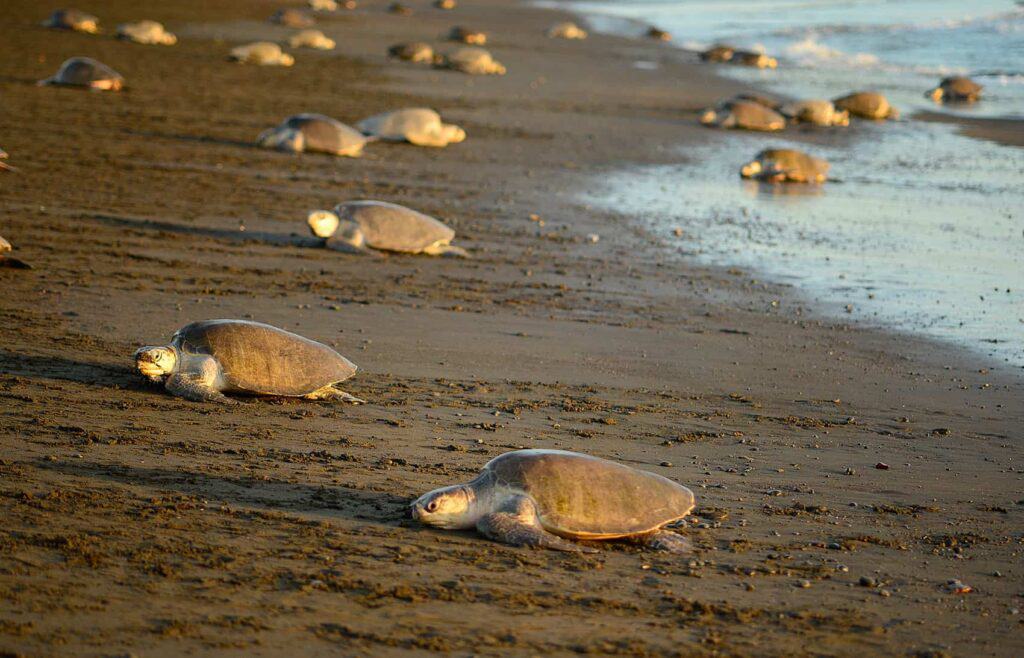
Costa Rica’s beaches are key spots for sea turtles like the olive ridley, leatherback, green, and hawksbill. These amazing creatures come to the country’s shores to nest, adding to its rich biodiversity. The olive ridley sea turtles are known for their arribada, gathering in huge numbers to lay eggs under the cover of night.
The green sea turtles nest from July to October, making Tortuguero National Park a top spot for this event. It’s the biggest nesting site for green sea turtles in the Western Hemisphere. Eco-tourists flock here to see this incredible sight. Tours are set up to help with conservation and teach visitors about the turtles’ lives.
Leatherback sea turtles, the biggest of their kind, can be over 1,200 pounds and nearly 8 feet long. They lay their eggs on various beaches, including those in Las Baulas National Marine Park, from October to mid-February. Hawksbill sea turtles are rare because they nest alone and their numbers are dropping, making seeing them a special event.
The chart below outlines key locations and information regarding nesting periods for different sea turtle species in Costa Rica:
| Beach Location | Sea Turtle Species | Nesting Period |
|---|---|---|
| Tortuguero Beach | Green | July to mid-October (peak in August to September) |
| Ostional Beach | Olive Ridley | September to October (with smaller numbers from January to June) |
| Las Baulas National Marine Park | Leatherback | October to mid-February |
| Nancite Beach | Olive Ridley | September to October |
| Hermosa Beach | Olive Ridley | July to December |
| Gandoca Beach | All Species | March to July |
| Osa Peninsula | Leatherback, Hawksbill, Green, Olive Ridley | March to September for Leatherback, June to December for Olive Ridley |
Eco-tourism plays a big role in helping protect these endangered sea turtles. By joining guided tours and being respectful, visitors help keep their habitats safe. Every year, thousands of baby turtles make their way out of their nests, showing us why it’s crucial to protect these amazing creatures and their homes.
Whales and Dolphins: Marine Mammals of the Pacific
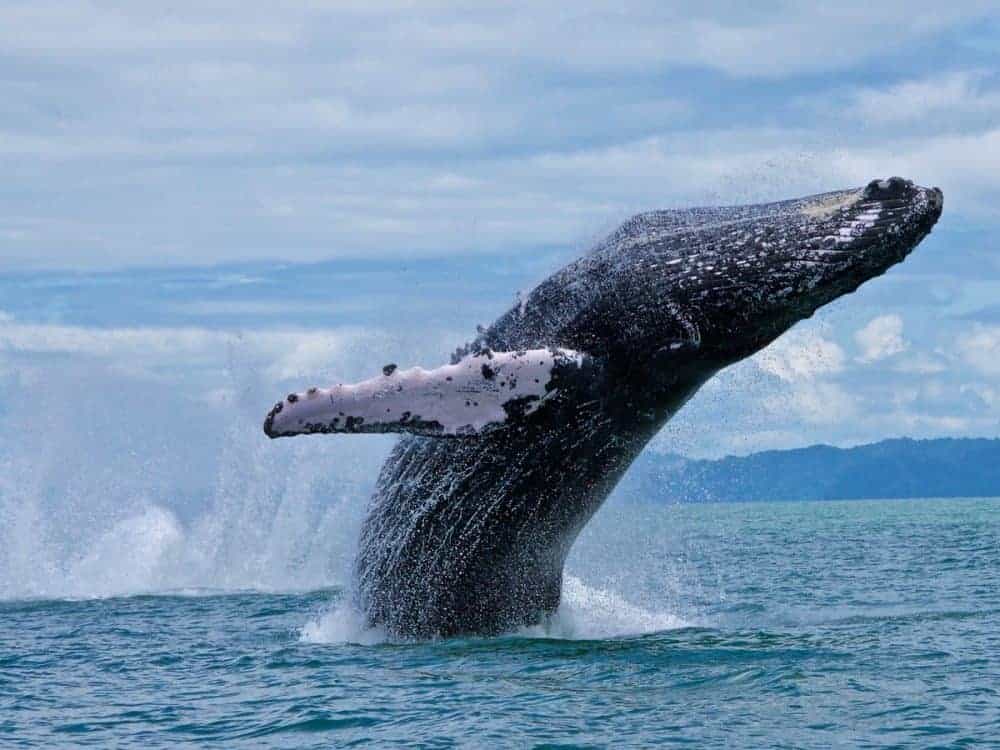
The Pacific coast of Costa Rica is perfect for those who love to see whales and dolphins. It’s one of the best places to see humpback whales all year. From December to April, you can watch these huge animals migrate from California to enjoy the warm waters.
During their peak months, you can see breeding pods near the Osa Peninsula and Marino Ballena National Park. This makes Costa Rica a top spot for eco-tourism.
Dolphins are another big attraction in Costa Rica. You can see Spinner, Bottlenose, and Spotted Dolphins in the water. From July to October and December to March, they have their breeding seasons.
These tours are great for adventure lovers. They offer a chance to see dolphins up close without disturbing them. This helps keep the marine life safe and healthy.
Setting sail on these tours is an exciting way to meet these friendly animals. Prices range from $50 for short trips to $150 for full-day adventures. You might even snorkel with dolphins. With about 25 species of whales and dolphins, your visit will surely be memorable.

